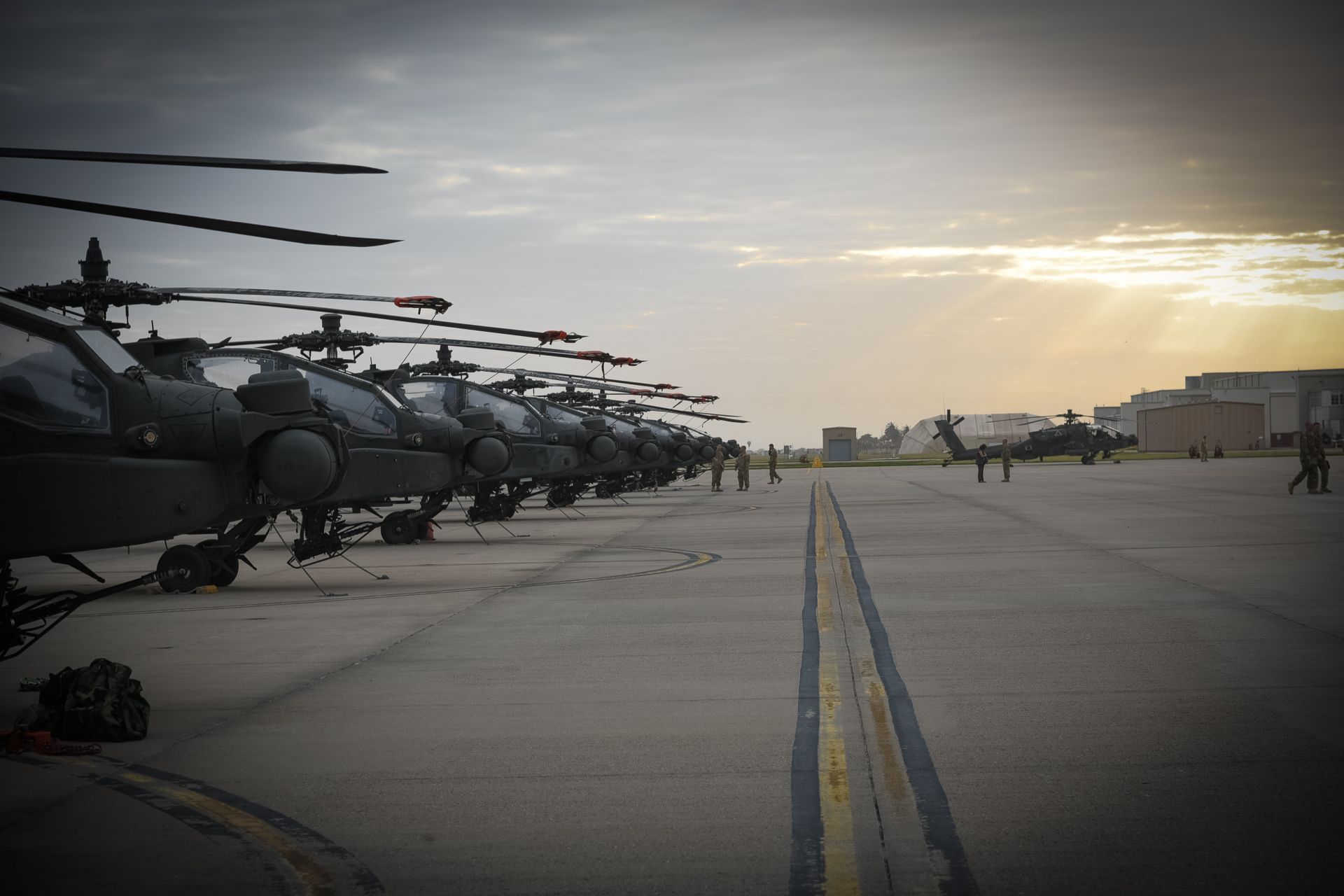A fleet of 20 AH-64 Apache aircraft from the 1st Battalion, 501st Aviation Regiment, 1st Armored Division in Fort Bliss, Texas landed at the Corpus Christi Army Depot last week to prepare for their February deployment to Europe.
The 1-501st, also known as the Iron Dragon Battalion, will deploy this February for a nine-month rotation in support of Operation Atlantic Resolve.
“We’re moving aircraft to Corpus Christi to put them on a ship to deploy to Europe,” said Lt. Col. Chris Crotzer, 1-501st commander.
“Supporting units like this sends a clear message to the rest of the Army that CCAD is willing to aid whenever we can to support the Warfighter and the overall mission,” said Maj. Nathan Patrick, the depot commander’s executive officer.
Maj. Patrick handles military-aviation-related matters at the Depot, including coordination with other military entities. He worked out the details of the 1-501st arrival and parking plan along the sea wall, even including a maintenance bay for their use, to ensure the 1-501st a smooth and effortless transition to the Port of Corpus Christi.
Though CCAD was ready and set to assist the deployment, this depot is not a normal pit stop for active battalions.
Through the Army Working Capital Fund, CCAD operates as an industrial facility specializing in helicopter maintenance, repair and overhaul under the US Aviation and Missile Command.
The Depot is renowned for its helicopter reset and modernization capabilities, prolonging the life-cycle of some of Army’s most-trusted rotary wing aircraft.
“It will take several days to load the aircraft on the ship” across town at the Port of Corpus Christi, said CW3 David Staruch, of the 1-501st. “We can only load a few [Apaches] at a time and have to remove the rotor blades and prep them for travel. There’s no heliport. It’s just a big massive ship.”
The original plan was for the 1-501st to ferry aircraft to the Port of Corpus Christi over the course of three days. The Port of Corpus Christi is one of the few ports in the Gulf of Mexico that can sustain a boat large enough to carry 20 helicopters safely across the Atlantic.
As luck would have it, high winds delayed the 1-501st move to the Port by a day, but it did little to slow down the Iron Dragon Battalion. Even with the loss of a day, the 1-501st was able to load all aircraft within the original three-day timeframe.
Through the cooperative efforts of Naval Air Station Corpus Christi, Chief of Naval Air Training and CCAD, the 1-501st and their helicopters safely assembled at CCAD and continued to the port safely, demonstrating the synergy it takes to put global readiness and regional responsiveness in action.
“It’s real easy working with the folks at CCAD. And the Navy and flight test folks have been fantastic. They’ve been helping us every day,” said Lt. Col. Crotzer.
According to Fort Bliss’s January tenth press release, approximately 400 Soldiers and 24 AH-64 Apache helicopters from the 1-501st will augment the 10th Combat Aviation Brigade, 10th Mountain Division, out of Fort Drum, New York, which is the first aviation brigade to support OAR under the Regionally Aligned Force concept.
These Soldiers will support aviation operations throughout Europe to improve interoperability and strengthen relationships with Allies and partner nations.
“We’ll get great training with the forces and get them comfortable working with us,” said Lt. Col. Crotzer.
The AH-64 Apache is the Army’s attack aviation asset used for close combat attack.
“We train with the Apache all the time and with our ground units to gain proficiency,” said Staruch. “We feel ready for the task at hand.”
The battalion trained hard for the past year at the National Training Center and through other standard exercises.
“Now we are going to Europe to train with the Allied Nations to do the same with them,” he said.
This training deployment will not only enhance US and European relations, it will add readiness to the US Army aviation’s attack reconnaissance battalion.
The Attack Reconnaissance Battalion self-deploys to any contingency area to conduct operations. On order, it will conduct military operations that will engage and destroy an enemy or peacefully perform missions that ensure regional stability in the area of operations.
The nine-month deployment to Europe is a first for this battalion who are relying on this training to gain the familiarity with some of the field conditions they may face when they are called to support their next mission.
“We exist to support the Warfighter,” Staruch said of the battalion. They provide cover for ground combatants — the guys on the ground — to achieve their mission.
“We’re looking forward to this exceptional opportunity to work with US Army Europe, our Allies and partners,” said Lt. Col. Crotzer.










